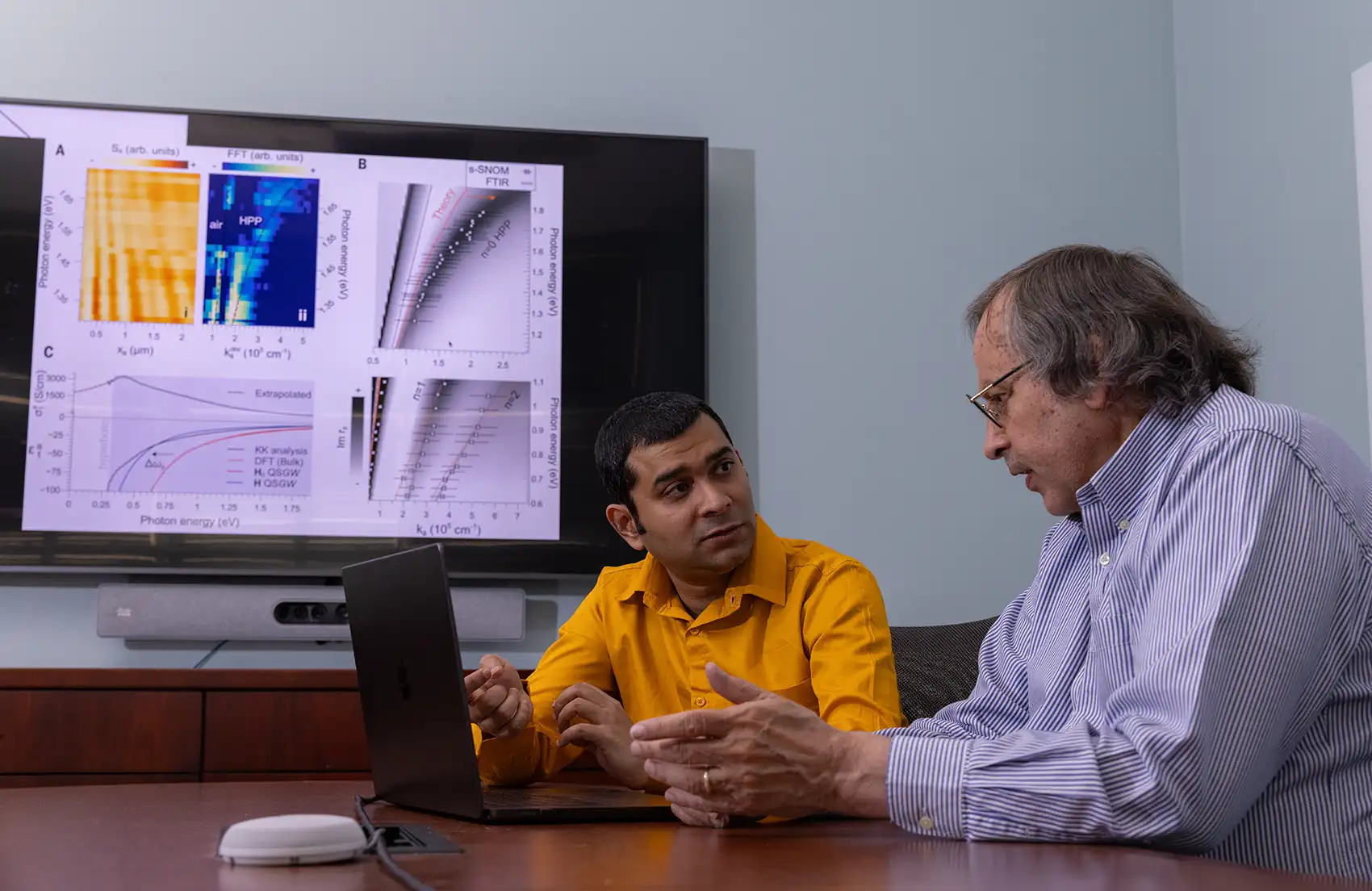About Advanced Research on Integrated Energy Systems
The Advanced Research on Integrated Energy Systems (ARIES) platform is designed to derisk, optimize, and secure current energy systems and provide insight into future energy systems that are clean, secure, resilient, reliable, and equitable.
Breaking Rules but Not Waves: Plasmons in Correlated Materials
Study Reveals Hybrid Plasmon-Polariton Resilience in Strongly Correlated Systems

Electronics often use a subclass of materials called correlated materials because they exhibit unique electronic and magnetic properties.
In these types of materials, the electrons interact with each other so intensely that their behavior is not describable by simple models, because the usual models of electrons acting like individual particles do not apply cleanly. Chemists and physicists aim to control these unusual behaviors to unlock properties that could power next-generation technologies.
Two researchers from NREL, alongside researchers from colleges, universities, and institutions in New York, California, Michigan, Colorado, London, Netherlands, and Canada, discovered that even in “bad” metals—where electron behavior is chaotic and incoherent—waves of collective electrical charge called plasmons can still form and travel throughout the material for an exceptionally long time. The waves’ “survival” provides new insights into how strong interactions between electrons shape the behavior of light and charge inside materials.
The research team published their findings in a paper titled “Good Plasmons in a Bad Metal” in Science. Funding for this work was provided by the U.S. Department of Energy's Office of Science with additional support from the Gordon and Betty Moore Foundation, European Research Council Synergy Grant, and Simons Foundation.
“Since plasmons are coherent, collective excitations,” said NREL’s Swagata Acharya, a materials physics researcher who contributed to this study, “it seems counterintuitive that they would be long lived in a highly chaotic system where electron motion is incoherent and resistance is high.”
Discovering Plasmons in a ‘Bad’ Metal
The research team leveraged specialized techniques to examine the nanostructures and electromagnetic properties in a metal called molybdenum dichloride dioxide (MoOCl2).
They expected that the plasmons, which are ripples of collective electrical charge, would be too weak to travel successfully across the material, especially at high temperatures that cause electrons to scatter and decohere. However, they found something surprising.
They observed special signals traveling through the material called hybrid plasmon-polaritons (HPPs). An HPP is a unique entity composed of an entangled soup of plasmons and a quantized light field, acting as a single particle.
The findings of this study were remarkable because, in a bad metal, electrons are incoherent and their excitations decay quickly, so they cannot be measured over a long period of time. Even though MoOCl2 is a bad metal, the HPPs remained strong and stable. The team discovered that by using advanced imaging and a theory that predicts and explains the origins of the dielectric response, the key feature that explains how plasmons are created and how long they survive.
“The experiments showed that HPPs can survive for as many as 10 cycles at room temperature,” said Mark van Schilfgaarde, NREL’s chief theorist who contributed to this study. “That’s an extraordinarily long time—more than any known crystal.”
New Possibilities for Future Technologies
Unlike many “good” metals used in electronics, which often require extra voltage or chemical treatment to create useful waves, MoOCl2 naturally supports long-lived plasmons without any special tuning. HPPs are a special kind of plasmon that make it possible to scan objects with a spatial resolution at the nanoscale, well below the classical optical limit of approximately half the wavelength of light—extending the reach of optical experiments.
“Besides the technological implications,” van Schilfgaarde said, “these findings can lead to new insights into correlated systems.”
Theory enables the interpretation of observed phenomena, empowers investigation of the mechanisms behind the phenomena, and provides guidance for future experiments.
Long-lived HPPs are much easier to work with, which makes MoOCl2 a highly promising candidate for next-generation optical devices. Its stability in air, ease of being peeled into ultrathin layers, and ability to interact with near-infrared light—all without breaking down—make it ideal for building compact, precise technologies. Beyond its practical potential, MoOCl2 also offers scientists a new platform to explore and explain how electrons behave in complex, strongly interacting systems.
“Plasmon polaritons are of high technological relevance because they are used in many applications such as highly sensitive chemical and biosensors, optical communication, high-resolution near-field optical microscopy, and solar cells,” said Jao van de Lagemaat, NREL Chemistry and Nanoscience Center director. “HPPs add an extra dimension of versatility to this application space.”
Learn more about basic energy sciences at NREL and about the U.S. Department of Energy's Office of Science Basic Energy Sciences program. Read “Good Plasmons in a Bad Metal” in Science.
Share
Last Updated Jan. 9, 2025
